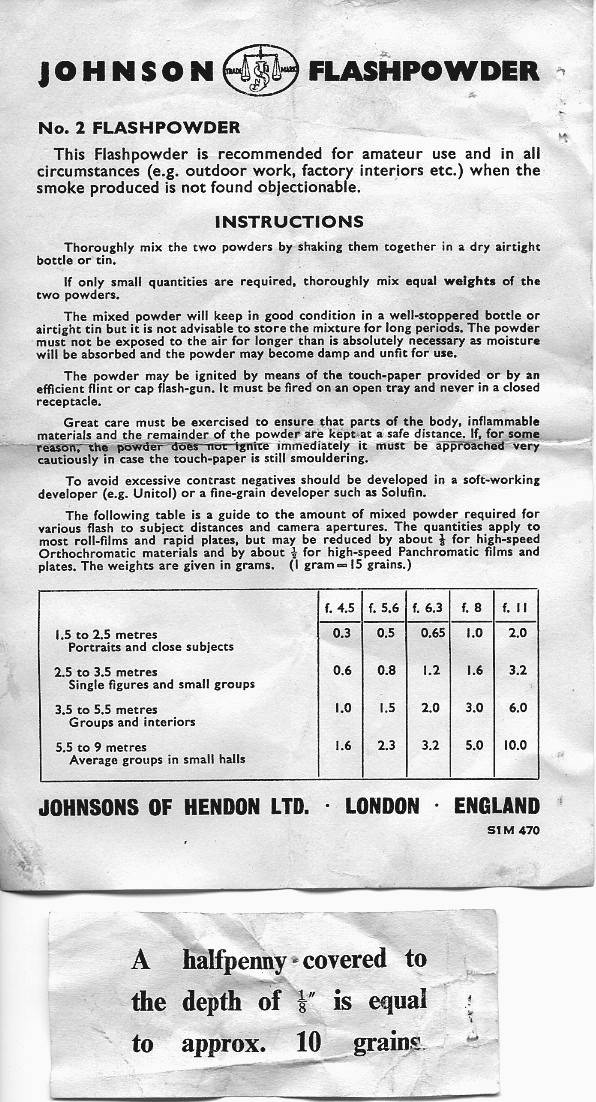| Johnson's No.2 FlashPowder |
|
|
|
|
|
|
| Below are two advertisements for Johnson's Flashpowder, scanned by Paul Godfrey from some pre-war Amateur Photographer and Cinematographer magazines purchased by Jim Fisk from Philip's Cameras of Norwich. The left hand image is from AP for 17th December 1930 and the right hand one is from AP for 11th February 1931. Paul says "Philip's Cameras, 22 Wensum Street, Norwich, Norfolk, NR13 1HY is an excellent shop for all non-digital photography and camera enthusiasts. It's run by Philip Spinks and is open from Wednesday to Saturday each week. Well worth a visit if you find yourself in Norwich at any time. Contact the shop using 'phone number 01603 625261". | |
 |
 |
Paul Godfrey recounts his own experiences with flash powder, below. |
|
| I bought this Johnson Flashlamp (see below) in about 1972 or 1973 from Doughty's of Regent Road, Great Yarmouth. Doughty's was a traditional photographic dealer selling cameras, films, darkroom equipment and materials. They were also a toy shop and a sports shop. The shop had a very large sign that was in the shape of a tennis racquet. Mr Doughty had been a prisoner of war in Japan and had returned after the war without his sight. Doughty's did not sell anything of Japanese origin. This policy rather restricted the diversity of their product line-up by the 1970s. | |
 |
 |
| Doughty's had a winter sale in 1972 or 1973 and the flashlamp was in their window priced at 75p. I expressed an interest in purchasing this item and was told by the young woman in the shop that I could not expect them to supply the flashpowder and they would not be making any refund if it transpired that I was unable to buy the powder elsewhere. | |
|
At the time I ran an adult
evening class in photography at Great Yarmouth College of Art
and Design (GYCAD) and I took the flashlight there to show the
members of the class. At the time the North Sea oil and gas industry
was at its peak and one member of the class, Walter Howard, who
I had been at school with, worked for an oil company that had
bases in Great Yarmouth and Aberdeen. The oil company employed
an industrial chemist and the following week a small tub of grey
powder was brought to the class. The evening class was in two halves beginners and advanced. I took the beginners off into the darkroom and left the advanced group alone with the flash. I returned to the advanced group about half an hour later and came into a room that appeared to be in a fog. I was encouraged to stand next to Maureen Smith, known to all as "Mosy", and her husband David took a photo of Mosy and me by open flash technique with me holding the flash, see below. Paul points out that this was taken over 37 years ago and he is no longer the slim young bloke that is in the photo. |
 |
 |
At 9 o'clock the GYCAD caretaker came round to lock-up and encourage us to go home. He saw the cloud and decided some of us had been smoking in there and was going to report us. The cloud seemed to be made of a grey coloured dust. After a while we noticed that the cloud was dropping and a clearer section had appeared below the ceiling. This cloud had a flat top that was formed by the ceiling and it came slowly down. After the evening class we retired to the Penrice Arms and emerged from there onto the car park that was on rough ground behind the 'pub. At the time I ran a 1951 Daimler DB 18 Consort saloon car and a small group gathered around it for a flash photograph. Jim Fisk, with his Leica M3 loaded with Tri-X, stopped down to f16 and took this photo by open flash technique while I operated the flash. The resulting negative was very well exposed. The picture shows David and Mosy Smith with Mike Russell who ran the GYCAD photography evening class before I did. |
 |
|
|
A week later I was given a large Horlicks jar containing a modified formula of the flash powder. Later I got rather panicky about possessing this item believing that it could spontaneously combust and after a while I decided to put it down a drain with lots of water. This made the mixture set rock hard like concrete and took loads of poking and prodding to get it go down the drain. I have since realised that damp flashpowder is even more dangerous than dry, but since there were no reports of exploding drains in Great Yarmouth, I think I got away with it ! Paul closes by saying how he gave up running the evening class around 1977 but to this day the "Tuesday Group" meets at 9 o'clock in the evening every Tuesday for an exchange of views on photography and other topics. "Myself, David Smith, Jim Fisk and Mike Russell still get together in a pub in Gorleston each Tuesday. We have done this for nearly 40 years and often reminisce about things that we did in the past". |
|
|
|
|
|
|
|
